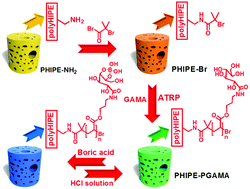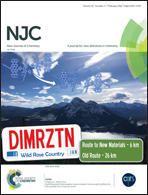Surface glycopolymer-modified functional macroporous polyHIPE obtained by ATRP for the removal of boron in water†
Abstract
Amino-functional macroporous polyHIPE-NH2 monoliths were surface modified with 2-bromo-2-methylpropionyl bromide and used as initiators to initiate atom transfer radical polymerization (ATRP) of the D-gluconamidoethyl methacrylate glycol-monomer (GAMA), resulting in a dense coating of polymers on the polyHIPE surface. PolyHIPE-PGAMA has plenty of –OH groups that can form a strong complex and can be used for boron removal. Different ratios of macroporous polymeric monoliths could be prepared through changing the amount of Span 80 and the oil/water ratio. The porosity, pore structure, mechanical properties and adsorption properties could also be changed. PolyHIPE-PGAMA exhibited rapid removal of boron at low boron concentration. The regeneration investigations showed that the monoliths could be reused by simply leaching and washing under acidic conditions to remove boron. The materials and methods to form the monoliths were simple and efficient, thus, opening up new possibilities for the adsorption of highly porous polyHIPE for separation applications.



 Please wait while we load your content...
Please wait while we load your content...